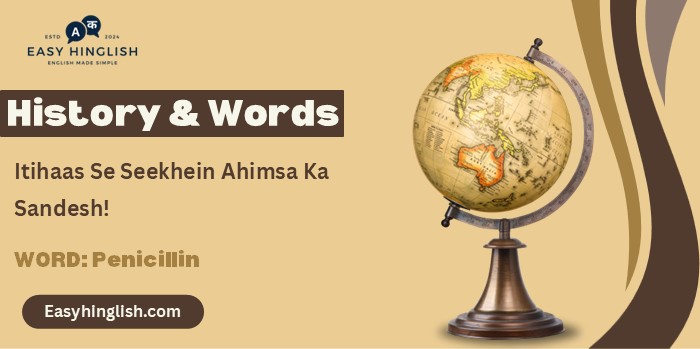History & Words: 'Penicillin' (October 3)
Welcome to 'History & Words.' Main Prashant hoon, Wordpandit aur Learning Inc. Network ka sansthapak. Yeh series meri bhasha seekhne ki lagan aur itihas ke prati ruchi ka sangam hai. Har kadi ek shabd aur uss se judi ek tithi par roshni daalti hai, jisse aapka shabdkosh badhta hai aur aap itihas ko gehraai se samajh paate hain. Aaiye, iss safar mein shabdon ke madhyam se samay mein pichhe chalein.
🔍 Aaj ka Shabd: Penicillin
Pronunciation: /ˌpɛnɪˈsɪlɪn/ (pen-i-SIL-in)
🌍 Parichay (Introduction)
October 3, 1928 ko London ke St. Mary's Hospital me ek Scottish bacteriologist Alexander Fleming apni laboratory me ek routine check kar raha tha. Unke bacterial culture plates me se ek me kuch unusual dikha – ek mold ne bacteria ko kill kar diya tha. Fleming ne socha hoga ki yeh sirf contamination hai, lekin unki curiosity ne unhe closer look lene par majboor kiya. Is moment ne medical history forever change kar di.
Yeh 'accidental' discovery actually penicillin ki thi – world's first true antibiotic jo millions of lives save karne wali thi. Fleming ka observation simple tha lekin revolutionary: Penicillium notatum mold ne Staphylococcus bacteria ko destroy kar diya tha. Yeh discovery medical science me ek turning point ban gayi aur 'antibiotic era' ki beginning mark kar di.
Penicillin ka impact sirf medicine tak limited nahi tha – iska effect World War II par, population growth par, aur healthcare systems par profound tha. Yeh discovery humanity ko bacterial infections se fighting chance diya, jo previously often fatal hote the.
🌱 Shabd ka Utpatti (Etymology)
"Penicillin" shabd ka origin directly mold se connected hai:
✅ "Penicillium" (genus name of the mold jo Latin "penicillus" se aaya hai)
✅ "Penicillus" Latin me "paintbrush" ka matlab hai, kyunki mold ka structure brush-like dikhaai deta hai
✅ "-in" suffix jo chemical compounds me commonly use hota hai
Fleming ne khud yeh naam suggest kiya tha because under microscope, Penicillium mold ki structure paintbrush jaise filaments jaisi dikhti thi. Initially, Fleming ne isse "mold juice" bula tha, but scientific naming me "penicillin" adopt hua.
Interestingly, term "antibiotic" Alexander Fleming ne nahi banaya tha – yeh term Selman Waksman ne 1942 me coin kiya tha, jo Greek words "anti" (against) aur "biotikos" (life) se bana hai.
📖 Mahatvapurn Shabdavali (Key Vocabulary)
- 🔑 Antibiotic: Bacteria ko kill karne ya unka growth rokne wale substances
- 🔑 Bacteriophage: Viruses jo bacteria ko infect karte hain (Fleming ka earlier research area)
- 🔑 Culture Plate: Laboratory dish jisme bacteria grow karte hain research ke liye
- 🔑 Penicillium notatum: Specific mold species jisse penicillin originally extract kiya gaya
- 🔑 Antimicrobial Resistance: Bacteria ka ability to survive antibiotic treatment – modern challenge
🏛️ Itihasik Sandarbh (Historical Context)
Penicillin se pehle, bacterial infections often death sentence hote the. Simple cuts, surgical procedures, ya childbirth complications frequently fatal ho jaate the infection ki wajah se. World War I me, soldiers infection se death rate combat injuries se zyada thi.
Fleming ka background interesting tha – woh initially shipping clerk tha before studying medicine. St. Mary's Hospital me unka research wounds aur infections par focused tha, especially war injuries ke context me. Unka earlier discovery lysozyme (1922 me) bhi natural antimicrobial agent tha, though limited effectiveness thi.
1928 me Fleming ka laboratory organized nahi tha – culture plates often improperly cleaned ya left uncovered hote the. Yeh 'messy' approach ironically discovery me help kar gaya. September me Fleming vacation par gaya tha aur wapas aane par contaminated plates check kar raha tha.
Discovery ke baad Fleming ne basic experiments kiye aur dekha ki penicillin various bacteria ke against effective hai, but not against all. However, usse penicillin ko purify karna ya mass produce karna nahi aaya. Yeh kaam later Howard Florey aur Ernst Boris Chain ne 1940s me kiya Oxford University me.

⏳ Samayrekha (Timeline)
- September 1928: Fleming vacation se wapas aaya, contaminated plates observe kiye
- October 3, 1928: Official discovery date jab Fleming ne mold ka antimicrobial effect confirm kiya
- 1929: Fleming ne discovery paper publish kiya, but limited interest mila
- 1940: Florey aur Chain ne penicillin research restart kiya Oxford me
- 1941: First human trials successful hue
- 1942: Mass production start hua US aur UK me
- 1943–45: World War II me widespread military use
- 1945: Fleming, Florey, aur Chain ko Nobel Prize in Medicine mila
- 1950s: Penicillin civilian population ke liye widely available hua
- 1960s–70s: First antibiotic resistance cases observe hue
🌟 Is Din ka Mahatva (The Day's Significance)
October 3, 1928 ka din medical history me watershed moment hai. Is din Fleming ne definitively confirm kiya ki jo mold unke culture plate me tha, woh bacteria-killing properties rakhta hai. Unhone systematic observations record kiye aur multiple experiments perform kiye to verify the effect.
Fleming ka approach scientific tha – unhone different bacterial strains test kiye aur notice kiya ki penicillin gram-positive bacteria ke against effective hai, but gram-negative bacteria ko affect nahi karta. Unhone yeh bhi observe kiya ki mold ka 'juice' dilute hone par bhi active rehta hai.
Lekin initially, Fleming ko nahi pata tha ki yeh discovery kitni revolutionary hogii. Unka initial paper 1929 me British Journal of Experimental Pathology me publish hua, but scientific community me limited response aya. Many scientists thought ki yeh sirf laboratory curiosity hai, practical application nahi.
Real breakthrough 1940s me aayi jab Howard Florey ki team ne mass production methods develop kiye. World War II ka timing crucial tha – wounded soldiers ka treatment immediate need tha, aur penicillin exactly woh solution provide kar raha tha jo war effort ke liye zaroori tha.
💬 Prasiddh Ukti (Quote)
"One sometimes finds what one is not looking for. When I woke up just after dawn on September 28, 1928, I certainly didn't plan to revolutionize all medicine by discovering the world's first antibiotic." — Alexander Fleming
🔮 Aaj Ka Matlab aur Chintan (Modern Usage and Reflection)
Aaj 'penicillin' sirf ek antibiotic ka naam nahi hai – yeh medical revolution ka symbol hai. Modern medicine me antibiotics ke bina surgery, chemotherapy, aur organ transplants impossible honge. Lekin contemporary challenges bhi hain – antibiotic resistance ek growing concern hai.
Over-prescription aur misuse ki wajah se many bacteria penicillin-resistant ho gaye hain. MRSA (Methicillin-resistant Staphylococcus aureus) jaise superbugs ka emergence dikhaata hai ki antibiotics ka responsible use kitna important hai.
Fleming khud predict kar gaya tha yeh problem – unhone warning di thi ki improper use se bacteria resistance develop kar sakte hain. Aaj WHO antibiotic resistance ko global health emergency consider karta hai.
🏛️ Virast (Legacy)
Penicillin ka discovery ne complete medical paradigm shift kar diya. Pre-antibiotic era me average life expectancy significantly low thi bacterial infections ki wajah se. Post-penicillin era me not only survival rates improve hue, balki complex medical procedures possible ho gaye.
Pharmaceutical industry ka modern structure largely antibiotics ki success par based hai. Drug discovery methods, clinical trials, aur regulatory frameworks jo aaj use hote hain, woh penicillin development process se evolved hue hain.
Fleming ka discovery accidental thi, but uske baad systematic drug discovery approach develop hua. Today, pharmaceutical companies billions invest karte hain new antibiotics develop karne me, though economic incentives challenging hain.
🔍 Tulnatmak Vishleshan (Comparative Analysis)
1928 me penicillin discovery purely serendipitous thi – Fleming ka 'messy' lab accidentally perfect conditions create kar gaya. Aaj drug discovery highly systematic aur technology-driven process hai, with computer modeling, genetic engineering, aur precision targeting.
Fleming ke time me clinical trials informal the aur regulation minimal tha. Today, drug approval process decades le sakti hai aur billions cost kar sakti hai. Safety standards dramatically improve hue hain, but innovation speed sometimes slow ho jaati hai.
Originally, penicillin natural product tha mold se extracted. Modern antibiotics often synthetic hain ya genetically engineered bacteria se produced hote hain. But basic principle same hai – selective toxicity jo bacteria ko harm kare but human cells ko spare kare.
💡 Kya Aapko Pata Hai? (Did You Know?)
🎓 Antim Vichar (Conclusion)
October 3, 1928 ko Fleming ka observation ek reminder hai ki scientific breakthroughs often unexpected places se aate hain. Penicillin discovery ne dikhaya ki nature me solutions exist karte hain humanity ke problems ke liye – hume sirf observe karne aur understand karne ki zaroorat hai.
Aaj jab hum antibiotic resistance ke challenges face kar rahe hain, Fleming ki discovery ka lesson yeh hai ki science me continuous innovation aur responsible use dono zaroori hain. Penicillin ne millions of lives save ki hain, aur iska proper stewardship ensure karega ki future generations ko bhi yeh benefits mile.
📚 Aage Padhne Ke Liye (Further Reading)
- 📖 "The Mold in Dr. Florey's Coat" – Eric Lax
- 📖 "Penicillin: Triumph and Tragedy" – John Mann
- 📖 "The Antibiotic Era: Reform, Resistance, and the Pursuit of a Rational Therapeutics" – Scott H. Podolsky








